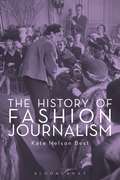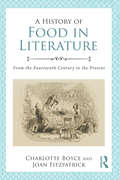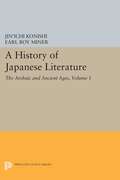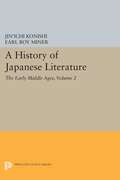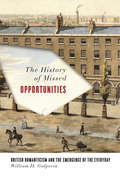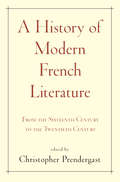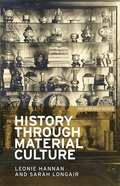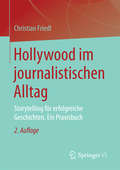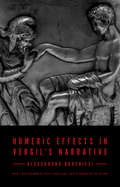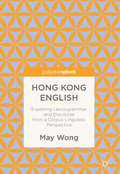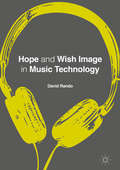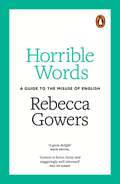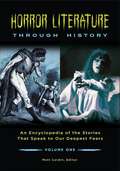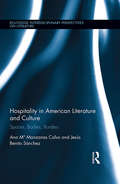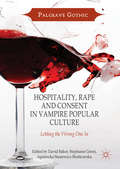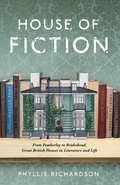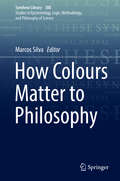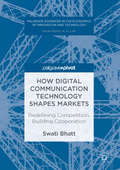- Table View
- List View
The History of Fashion Journalism
by Kate Nelson BestThe History of Fashion Journalism is a uniquely comprehensive study of the development of the industry from its origins to the present day, and including professionals' such as Dylan Jones's vision of the future. Covering everything from early tailor's catalogues through to contemporary publications such as LOVE, together with blogs such as StyleBubble, and countries from France through to the United States, The History of Fashion Journalism explores the origins and influence of such well-known magazines as Nova, Vogue and Glamour. Combining an overview of the key moments in fashion journalism history with close textual analysis, Kate Nelson Best brings to life the evolving face of the fashion media and its relationship with the fashion industry, national politics, consumer culture and gender. This accessible and highly engaging book will be an invaluable resource not only for fashion studies students but also for those in media studies and cultural studies.
A History of Food in Literature: From the Fourteenth Century to the Present
by Charlotte Boyce Joan FitzpatrickWhen novels, plays and poems refer to food, they are often doing much more than we might think. Recent critical thinking suggests that depictions of food in literary works can help to explain the complex relationship between the body, subjectivity and social structures. A History of Food in Literature provides a clear and comprehensive overview of significant episodes of food and its consumption in major canonical literary works from the medieval period to the twenty-first century. This volume contextualises these works with reference to pertinent historical and cultural materials such as cookery books, diaries and guides to good health, in order to engage with the critical debate on food and literature and how ideas of food have developed over the centuries. Organised chronologically and examining certain key writers from every period, including Chaucer, Shakespeare, Austen and Dickens, this book's enlightening critical analysis makes it relevant for anyone interested in the study of food and literature.
A History of Food in Literature: From the Fourteenth Century to the Present
by Charlotte Boyce Joan FitzpatrickWhen novels, plays and poems refer to food, they are often doing much more than we might think. Recent critical thinking suggests that depictions of food in literary works can help to explain the complex relationship between the body, subjectivity and social structures. A History of Food in Literature provides a clear and comprehensive overview of significant episodes of food and its consumption in major canonical literary works from the medieval period to the twenty-first century. This volume contextualises these works with reference to pertinent historical and cultural materials such as cookery books, diaries and guides to good health, in order to engage with the critical debate on food and literature and how ideas of food have developed over the centuries. Organised chronologically and examining certain key writers from every period, including Chaucer, Shakespeare, Austen and Dickens, this book's enlightening critical analysis makes it relevant for anyone interested in the study of food and literature.
A History of Japanese Literature, Volume 1: The Archaic and Ancient Ages (PDF)
by Jin'Ichi Konishi Earl Roy Miner Nicholas TeeleThis book, which covers the period from preliterate times to the beginning of the tenth century, is the first of five proposed volumes that will give an account of Japanese literature from its beginnings to the death of the modern novelist Mishima.Originally published in 1984.The Princeton Legacy Library uses the latest print-on-demand technology to again make available previously out-of-print books from the distinguished backlist of Princeton University Press. These editions preserve the original texts of these important books while presenting them in durable paperback and hardcover editions. The goal of the Princeton Legacy Library is to vastly increase access to the rich scholarly heritage found in the thousands of books published by Princeton University Press since its founding in 1905.
A History of Japanese Literature, Volume 2: The Early Middle Ages (PDF)
by Jin'Ichi Konishi Earl Roy Miner Nicholas TeeleThe second of live volumes planned to give a systematic account of Japanese literature from its beginnings to the death of the modern novelist Mishima, this book establishes the character of the literature of the early Middle Ages, from the ninth to the mid-twelfth century.Originally published in 1986.The Princeton Legacy Library uses the latest print-on-demand technology to again make available previously out-of-print books from the distinguished backlist of Princeton University Press. These editions preserve the original texts of these important books while presenting them in durable paperback and hardcover editions. The goal of the Princeton Legacy Library is to vastly increase access to the rich scholarly heritage found in the thousands of books published by Princeton University Press since its founding in 1905.
The History of Missed Opportunities: British Romanticism and the Emergence of the Everyday
by William GalperinThrough close engagement with the work of Wordsworth, Austen, and Byron, The History of Missed Opportunities posits that the everyday first emerged as a distinct category of experience, or first became thinkable, in the Romantic period. Conceived here as something overlooked and only noticed in retrospect, the everyday not only becomes subject matter for Romanticism, it also structures Romantic poetry, prose, and writing habits. Because the everyday is not noticed the first time around, it comes to be thought of as a missed opportunity, a possible world that was not experienced or taken advantage of and of whose history—or lack thereof—writers become acutely conscious. Consciousness of the everyday also entails a new relationship to time, as the Romantics turn to the history of what might have been. In recounting Romanticism's interest in making things recurrently present, in recovering a past of what was close at hand yet underappreciated, William H. Galperin positions the Romantics as precursors to twentieth-century thinkers of the everyday, including Heidegger, Benjamin, Lefebvre, and Cavell. He attends to Romantic discourse that works at cross purposes with standard accounts of both Romanticism and Romantic subjectivity. Instead of individualizing or turning inward, the Romantics' own discourse depersonalizes or exhibits a confrontation with thing-ness and the material world.
A History of Modern French Literature: From the Sixteenth Century to the Twentieth Century
by Christopher PrendergastAn accessible and authoritative new history of French literature, written by a highly distinguished transatlantic group of scholarsThis book provides an engaging, accessible, and exciting new history of French literature from the Renaissance through the twentieth century, from Rabelais and Marguerite de Navarre to Samuel Beckett and Assia Djebar. Christopher Prendergast, one of today's most distinguished authorities on French literature, has gathered a transatlantic group of more than thirty leading scholars who provide original essays on carefully selected writers, works, and topics that open a window onto key chapters of French literary history. The book begins in the sixteenth century with the formation of a modern national literary consciousness, and ends in the late twentieth century with the idea of the "national" coming increasingly into question as inherited meanings of "French" and "Frenchness" expand beyond the geographical limits of mainland France.Provides an exciting new account of French literary history from the Renaissance to the end of the twentieth centuryFeatures more than thirty original essays on key writers, works, and topics, written by a distinguished transatlantic group of scholarsIncludes an introduction and indexThe contributors include Etienne Beaulieu, Christopher Braider, Peter Brooks, Mary Ann Caws, David Coward, Nicholas Cronk, Edwin M. Duval, Mary Gallagher, Raymond Geuss, Timothy Hampton, Nicholas Harrison, Katherine Ibbett, Michael Lucey, Susan Maslan, Eric Méchoulan, Hassan Melehy, Larry F. Norman, Nicholas Paige, Roger Pearson, Christopher Prendergast, Jean-Michel Rabaté, Timothy J. Reiss, Sarah Rocheville, Pierre Saint-Amand, Clive Scott, Catriona Seth, Judith Sribnai, Joanna Stalnaker, Aleksandar Stević, Kate E. Tunstall, Steven Ungar, and Wes Williams.
A History of Modern French Literature: From the Sixteenth Century to the Twentieth Century (PDF)
by Christopher PrendergastAn accessible and authoritative new history of French literature, written by a highly distinguished transatlantic group of scholarsThis book provides an engaging, accessible, and exciting new history of French literature from the Renaissance through the twentieth century, from Rabelais and Marguerite de Navarre to Samuel Beckett and Assia Djebar. Christopher Prendergast, one of today's most distinguished authorities on French literature, has gathered a transatlantic group of more than thirty leading scholars who provide original essays on carefully selected writers, works, and topics that open a window onto key chapters of French literary history. The book begins in the sixteenth century with the formation of a modern national literary consciousness, and ends in the late twentieth century with the idea of the "national" coming increasingly into question as inherited meanings of "French" and "Frenchness" expand beyond the geographical limits of mainland France.Provides an exciting new account of French literary history from the Renaissance to the end of the twentieth centuryFeatures more than thirty original essays on key writers, works, and topics, written by a distinguished transatlantic group of scholarsIncludes an introduction and indexThe contributors include Etienne Beaulieu, Christopher Braider, Peter Brooks, Mary Ann Caws, David Coward, Nicholas Cronk, Edwin M. Duval, Mary Gallagher, Raymond Geuss, Timothy Hampton, Nicholas Harrison, Katherine Ibbett, Michael Lucey, Susan Maslan, Eric Méchoulan, Hassan Melehy, Larry F. Norman, Nicholas Paige, Roger Pearson, Christopher Prendergast, Jean-Michel Rabaté, Timothy J. Reiss, Sarah Rocheville, Pierre Saint-Amand, Clive Scott, Catriona Seth, Judith Sribnai, Joanna Stalnaker, Aleksandar Stević, Kate E. Tunstall, Steven Ungar, and Wes Williams.
History through material culture (IHR Research Guides)
by Leonie Hannan Sarah LongairHistory through material culture is a unique, step-by-step guide for students and researchers who wish to use objects as historical sources. Responding to the significant, scholarly interest in historical material culture studies, this book makes clear how students and researchers ready to use these rich material sources can make important, valuable and original contributions to history. Written by two experienced museum practitioners and historians, the book recognises the theoretical and practical challenges of this approach and offers clear advice on methods to get the best out of material culture research. With a focus on the early modern and modern periods, this volume draws on examples from across the world and demonstrates how to use material culture to answer a range of enquiries, including social, economic, gender, cultural and global history.
History through material culture (IHR Research Guides)
by Leonie Hannan Sarah LongairPeople live in material worlds and the things we make, wear, sit upon, treasure or discard are key to understanding our lives and societies. As material culture is central to human experience, it represents a vital but under-used source for historians. Written in a lively and accessible style, this new guide provides clear and practical guidance on how to incorporate the study of objects into historical practice.
Hollywood im journalistischen Alltag: Storytelling für erfolgreiche Geschichten. Ein Praxisbuch
by Christian FriedlDer Band beantwortet die Frage: Was ist eine Geschichte und wie erzähle ich sie am besten? Er greift dabei das zentrale Motiv der "Heldenreise" auf. Sie ist eine Art Baukasten, aus dem sich Geschichtenerzähler kinderleicht bedienen können. Im Prinzip handelt es sich um eine angereicherte Form der 3-Akt-Struktur nach Aristoteles. Alle berühmten Hollywood-Regisseure benutzen sie, kaum ein Blockbuster kommt ohne sie aus. Was für Hollywood gilt, sollte auch für den Journalismus möglich sein, denn das Übernehmen von Erzählformen ist keine Frage des Geldes. Dieses Buch enthält Drehbuch-Ausschnitte aus Hollywood-Filmen, um die dramaturgischen Strukturen zu erläutern und veranschaulicht anhand von zahlreichen Beispielen aus Fernsehen, Hörfunk und Zeitung, wie man sie im Alltag anwenden kann. Für die zweite Auflage wurden die Filmbeispiele aktualisiert, der theoretische Teil um die Sequenzierung erweitert sowie weitere Beispiele aus dem journalistischen Alltag ergänzt.
Homeric Effects in Vergil's Narrative
by Alessandro Barchiesi Ilaria Marchesi Matt Fox Philip HardieThe study of Homeric imitations in Vergil has one of the longest traditions in Western culture, starting from the very moment the Aeneid was circulated. Homeric Effects in Vergil's Narrative is the first English translation of one of the most important and influential modern studies in this tradition. In this revised and expanded edition, Alessandro Barchiesi advances innovative approaches even as he recuperates significant earlier interpretations, from Servius to G. N. Knauer.Approaching Homeric allusions in the Aeneid as "narrative effects" rather than glimpses of the creative mind of the author at work, Homeric Effects in Vergil's Narrative demonstrates how these allusions generate hesitations and questions, as well as insights and guidance, and how they participate in the creation of narrative meaning. The book also examines how layers of competing interpretations in Homer are relevant to the Aeneid, revealing again the richness of the Homeric tradition as a component of meaning in the Aeneid. Finally, Homeric Effects in Vergil's Narrative goes beyond previous studies of the Aeneid by distinguishing between two forms of Homeric intertextuality: reusing a text as an individual model or as a generic matrix.For this edition, a new chapter has been added, and in a new afterword the author puts the book in the context of changes in the study of Latin literature and intertextuality.A masterful work of classical scholarship, Homeric Effects in Vergil's Narrative also has valuable insights for the wider study of imitation, allusion, intertextuality, epic, and literary theory.
Homeric Effects in Vergil's Narrative
by Alessandro Barchiesi Ilaria Marchesi Matt Fox Philip HardieThe study of Homeric imitations in Vergil has one of the longest traditions in Western culture, starting from the very moment the Aeneid was circulated. Homeric Effects in Vergil's Narrative is the first English translation of one of the most important and influential modern studies in this tradition. In this revised and expanded edition, Alessandro Barchiesi advances innovative approaches even as he recuperates significant earlier interpretations, from Servius to G. N. Knauer.Approaching Homeric allusions in the Aeneid as "narrative effects" rather than glimpses of the creative mind of the author at work, Homeric Effects in Vergil's Narrative demonstrates how these allusions generate hesitations and questions, as well as insights and guidance, and how they participate in the creation of narrative meaning. The book also examines how layers of competing interpretations in Homer are relevant to the Aeneid, revealing again the richness of the Homeric tradition as a component of meaning in the Aeneid. Finally, Homeric Effects in Vergil's Narrative goes beyond previous studies of the Aeneid by distinguishing between two forms of Homeric intertextuality: reusing a text as an individual model or as a generic matrix.For this edition, a new chapter has been added, and in a new afterword the author puts the book in the context of changes in the study of Latin literature and intertextuality.A masterful work of classical scholarship, Homeric Effects in Vergil's Narrative also has valuable insights for the wider study of imitation, allusion, intertextuality, epic, and literary theory.
Hong Kong English: Exploring Lexicogrammar and Discourse from a Corpus-Linguistic Perspective
by May WongThis book systematically examines the linguistic features and socio-cultural issues of ‘Hong Kong English’. The author focuses on authentic data taken from the International Corpus of English (the Hong Kong component) and the Corpus of Global Web-based English to track the ways in which the English language in Hong Kong has been adapted by its users. She also analyses the emergence of new forms and structures in its grammar and discourse. While the phonetic and phonological aspects of this variety of English have been well documented, its grammatical peculiarities and social language use have been hitherto neglected. This book offers original insights into the grammatical and pragmatic/discoursal features of Hong Kong English and will therefore be of interest to those working in fields such as World Englishes and corpus linguistics.
Hope and Wish Image in Music Technology
by David P. RandoThis book proposes that new music technologies attract unconscious desires for socialism and collectivity, enabling millions of people living under capitalism to dream of repressed social alternatives. Grounded in the philosophical writings of Ernst Bloch and Walter Benjamin, the book examines file sharing technologies, streaming services, and media players, as well as their historical antecedents, such as the player piano, cassette tape, radio and compact disc, alongside interpretations of fiction, memoir, and albums. Through the concept of wish images—the unconscious hopes and desires for social alternatives that gather around new technologies—the book identifies the repressed pre- and post-capitalist urges that attend our music technologies. While these desires typically remain unconscious and tend to pass away not only unmet but also unrecognized, Hope and Wish Image in Music Technology attempts to bring wishes for social alternatives to the surface at an auspicious moment of technological transition.
Hope and Wish Image in Music Technology (PDF)
by David P. RandoThis book proposes that new music technologies attract unconscious desires for socialism and collectivity, enabling millions of people living under capitalism to dream of repressed social alternatives. Grounded in the philosophical writings of Ernst Bloch and Walter Benjamin, the book examines file sharing technologies, streaming services, and media players, as well as their historical antecedents, such as the player piano, cassette tape, radio and compact disc, alongside interpretations of fiction, memoir, and albums. Through the concept of wish images—the unconscious hopes and desires for social alternatives that gather around new technologies—the book identifies the repressed pre- and post-capitalist urges that attend our music technologies. While these desires typically remain unconscious and tend to pass away not only unmet but also unrecognized, Hope and Wish Image in Music Technology attempts to bring wishes for social alternatives to the surface at an auspicious moment of technological transition.
Horrible Words: A Guide to the Misuse of English
by Rebecca GowersNothing inflames the language gripers like a misplaced disinterested, an illogical irregardless, a hideous operationalisation. To purists these are 'howlers' and 'non-words', fit only for scorn. But in their rush to condemn such terms, are the naysayers missing something? In this provocative and hugely entertaining book, Rebecca Gowers throws light on a great array of horrible words, and shows how the diktats of the pedants are repeatedly based on misinformation, false reasoning and straight-up snobbery. The result is a brilliant work of history, a surreptitious introduction to linguistics, and a mischievous salute to the misusers of the language. It is also a bold manifesto asserting our common rights over English, even as it questions the true nature of style.
Horror Literature through History [2 volumes]: An Encyclopedia of the Stories That Speak to Our Deepest Fears [2 volumes]
by Editor Matt CardinThis two-volume set offers comprehensive coverage of horror literature that spans its deep history, dominant themes, significant works, and major authors, such as Stephen King, Edgar Allan Poe, and Anne Rice, as well as lesser-known horror writers.Many of today's horror story fans—who appreciate horror through movies, television, video games, graphic novels, and other forms—probably don't realize that horror literature is not only one of the most popular types of literature but one of the oldest. People have always been mesmerized by stories that speak to their deepest fears. Horror Literature through History shows 21st-century horror fans the literary sources of their favorite entertainment and the rich intrinsic value of horror literature in its own right. Through profiles of major authors, critical analyses of important works, and overview essays focused on horror during particular periods as well as on related issues such as religion, apocalypticism, social criticism, and gender, readers will discover the fascinating early roots and evolution of horror writings as well as the reciprocal influence of horror literature and horror cinema.This unique two-volume reference set provides wide coverage that is current and compelling to modern readers—who are of course also eager consumers of entertainment. In the first section, overview essays on horror during different historical periods situate works of horror literature within the social, cultural, historical, and intellectual currents of their respective eras, creating a seamless narrative of the genre's evolution from ancient times to the present. The second section demonstrates how otherwise unrelated works of horror have influenced each other, how horror subgenres have evolved, and how a broad range of topics within horror—such as ghosts, vampires, religion, and gender roles—have been handled across time. The set also provides alphabetically arranged reference entries on authors, works, and specialized topics that enable readers to zero in on information and concepts presented in the other sections.
Hospitality in American Literature and Culture: Spaces, Bodies, Borders (Routledge Transnational Perspectives on American Literature)
by Ana Maria Manzanas Calvo Jesús Benito SanchezThis volume examines hospitality in American immigrant literature and culture, situating this ancient virtue at the crossroads of space and border theory, and exploring the relationship among the intersecting themes of migration, citizenship, identity formation, and spatiality. Assessing the conditions, duration, and shifting roles of hosts and guests in the United States, the book concentrates on the ways the US administers protocols of belonging and non-belonging, and distinguishes between those who can feel at home from those who will always be outside the body politic, even if they were the original "hosts." The volume opens with a genealogy of hospitality through a focus on its sites, from its origins in the Bible, to its national and post-national renditions in contemporary American literature and culture. The authors explore recent representations of immigrant spatiality, from the space of the body in Spielberg’s The Terminal and Frears’s Dirty Pretty Things, to the different ways in which immigrants are incorporated into the United States in Alex Rivera’s Sleep Dealer, Karen T. Yamashita’s I Hotel, Junot Díaz’s "Invierno," and Ernesto Quiñonez’s Chango’s Fire, concluding with the spectrality of the immigrant body in George Saunders’ "The Semplica Girl Diaries." Timely and imperative in light of the legacies of colonialism, and the realities of modern-day globalization, this book will be of value to specialists in post-colonialism; American Studies; immigration, diaspora, and border studies; and critical race and gender studies for its innovative approaches to media and literary texts.
Hospitality in American Literature and Culture: Spaces, Bodies, Borders (Routledge Transnational Perspectives on American Literature)
by Ana Maria Manzanas Calvo Jesús Benito SanchezThis volume examines hospitality in American immigrant literature and culture, situating this ancient virtue at the crossroads of space and border theory, and exploring the relationship among the intersecting themes of migration, citizenship, identity formation, and spatiality. Assessing the conditions, duration, and shifting roles of hosts and guests in the United States, the book concentrates on the ways the US administers protocols of belonging and non-belonging, and distinguishes between those who can feel at home from those who will always be outside the body politic, even if they were the original "hosts." The volume opens with a genealogy of hospitality through a focus on its sites, from its origins in the Bible, to its national and post-national renditions in contemporary American literature and culture. The authors explore recent representations of immigrant spatiality, from the space of the body in Spielberg’s The Terminal and Frears’s Dirty Pretty Things, to the different ways in which immigrants are incorporated into the United States in Alex Rivera’s Sleep Dealer, Karen T. Yamashita’s I Hotel, Junot Díaz’s "Invierno," and Ernesto Quiñonez’s Chango’s Fire, concluding with the spectrality of the immigrant body in George Saunders’ "The Semplica Girl Diaries." Timely and imperative in light of the legacies of colonialism, and the realities of modern-day globalization, this book will be of value to specialists in post-colonialism; American Studies; immigration, diaspora, and border studies; and critical race and gender studies for its innovative approaches to media and literary texts.
Hospitality, Rape and Consent in Vampire Popular Culture
by David Baker Stephanie Green Agnieszka Stasiewicz-BieńkowskaThis unique study explores the vampire as host and guest, captor and hostage: a perfect lover and force of seductive predation. From Dracula and Carmilla, to True Blood and The Originals, the figure of the vampire embodies taboos and desires about hospitality, rape and consent. The first section welcomes the reader into ominous spaces of home, examining the vampire through concepts of hospitality and power, the metaphor of threshold, and the blurred boundaries between visitation, invasion and confinement. Section two reflects upon the historical development of vampire narratives and the monster as oppressed, alienated Other. Section three discusses cultural anxieties of youth, (im)maturity, childhood agency, abuse and the age of consent. The final section addresses vampire as intimate partner, mapping boundaries between invitation, passion and coercion. With its fresh insight into vampire genre, this book will appeal to academics, students and general public alike.
The House of Fiction: From Pemberley to Brideshead, Great British Houses in Literature and Life
by Phyllis RichardsonHouses in literature have captured readers’ imaginations for centuries, from Gothic castles to Georgian stately homes, Bloomsbury townhouses and high-rise penthouses. Step on to a tour of real and imagined houses that great English writers have used to reflect the themes of their novels… houses that became like characters themselves, embodiments of the social and historical currents of their time.Phyllis Richardson takes us on a journey through history to discover how authors’ personal experiences in their homes helped to shape the imaginative dwellings that have become icons of English literature:Virginia Woolf’s love of Talland House in Cornwall is palpable in To the Lighthouse, just as London’s Bloomsbury is ever-present in Mrs Dalloway. E.M. Forster’s childhood home at Rook’s Nest mirrors the idyllic charm of Howards End. Evelyn Waugh plotted Charles Ryder’s return to Brideshead while a guest at Madresfield. Jane Austen was no stranger to a manor house or a good ballroom. And Horace Walpole’s ‘little Gothic castle’ in Twickenham inspired him to write the first English Gothic novel, The Castle of Otranto.But the English country house, from the idyllic to the unloved, is also viewed through a modern lens – Kazuo Ishiguro’s Darlington Hall, Ian McEwan’s Tallis House, Alan Hollinghurts’s Two Acres.Using historic sources, authors’ biographies, letters, news accounts, and the novels themselves, The House of Fiction presents some of the most influential houses in Britain through the stories they inspired, while offering candid glimpses of the writers who brought them to life.
How Colours Matter to Philosophy (Synthese Library #388)
by Marcos SilvaThis edited volume explores the different and seminal ways colours matter to philosophy. Each chapter provides an insightful analysis of one or more cases in which colours raise philosophical problems in different areas and periods of philosophy. This historically informed discussion examines both logical and linguistic aspects, covering such areas as the mind, aesthetics and the foundations of mathematics. The international contributors look at traditional epistemological and metaphysical issues on the subjectivity and objectivity of colours. In addition, they also assess phenomenological problems typical of the continental tradition and contemporary problems in the philosophy of mind. The chapters include coverage of such topics as Newton’s and Goethe’s theory of light and colours, how primary qualities are qualitative and colours are primary, explaining colour phenomenology, and colour in cognition, language and philosophy. "This book beautifully prepares the ground for the next steps in our research on and philosophising about colour" Daniel D. Hutto (University of Wollongong)"It is not an overstatement to say that How Colours to Philosophy is a ground breaking publication" Mazviita Chirimuuta (University of Pittsburgh)"Anyone interested in philosophical issues about color will find it highly stimulating." Martine Nida-Rümelin (Université de Fribourg)"The high quality papers included in this anthology succeed admirably in enriching current philosophical thinking about colour” Erik Myin (University of Antwerp)“This is certainly the most complete collection of philosophical essays on colours ever published” André Leclerc (University of Brasília)“All in all this collections represents a new milestone in the ongoing philosophical debate on colours and colour expressions” Ingolf Max (University of Leipzig)
How Digital Communication Technology Shapes Markets: Redefining Competition, Building Cooperation
by Swati BhattThis Palgrave Pivot explores how communication technology such as the Internet has changed the nature of trade, focusing especially on economy-wide reductions in company size (granularity) and the role of retailers (disintermediation). By increasing access to comparative data, influencing conceptions of time, and reducing the number of intermediaries between creator and consumer, technological connectivity is changing the very definition of competition. In the new network economy, disintermediation and granularity are turning cooperative information gathering and sharing into a vital market institution.To exemplify the effects of communication technology, Bhatt focuses on two markets with particularly powerful effects on the economy: labor and education, and CIME (communication, information services, media, and entertainment). Mobile connectivity is radically changing the extent, capabilities, and operations of these markets, both in terms of the services they provide and how they interact with consumers. Bhatt also explores how these benefits intersect with new concerns about privacy and security when the line between public and private information is becoming ever more fluid.
How Digital Communication Technology Shapes Markets: Redefining Competition, Building Cooperation
by Swati BhattThis Palgrave Pivot explores how communication technology such as the Internet has changed the nature of trade, focusing especially on economy-wide reductions in company size (granularity) and the role of retailers (disintermediation). By increasing access to comparative data, influencing conceptions of time, and reducing the number of intermediaries between creator and consumer, technological connectivity is changing the very definition of competition. In the new network economy, disintermediation and granularity are turning cooperative information gathering and sharing into a vital market institution.To exemplify the effects of communication technology, Bhatt focuses on two markets with particularly powerful effects on the economy: labor and education, and CIME (communication, information services, media, and entertainment). Mobile connectivity is radically changing the extent, capabilities, and operations of these markets, both in terms of the services they provide and how they interact with consumers. Bhatt also explores how these benefits intersect with new concerns about privacy and security when the line between public and private information is becoming ever more fluid.
